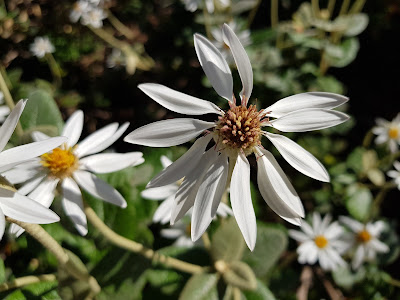Daisy drama in the botanic garden
The native Silver Daisy-bush, Olearia pannosa, grows naturally in South Australia and in Victoria but the namesake variant - subspecies pannosa - is restricted to, and quite rare, in what is now mostly farmland in South Australia.
A second variant, subspecies cardiophylla, named after its (slightly more) heart-shaped leaves, is found in South Australia and Victoria, where it is also rather rare and scattered in distribution. In addition to leaf shape, the varieties differ in the colour and orientation of the hairs on the very hairy leaves. We call this subspecies the Velvet Daisy-bush.
Like last week's boronia, this species grows very nicely outside the National Herbarium of Victoria in Melbourne Gardens. It was in full flower, and early seed set, in early October.
It's a big proportioned plant, and dramatic when it flowers in its dry forest habitat. Bushes can be up to a metre high, with the velvety leaves to 12 centimetres long and flower heads three to eight centimetres across. While daisies are rather common and often overlooked in our garden this one definitely stands out in the Australian bush, or your local botanic garden.
Perhaps surprisingly, individual plants live for more than 38 years, supported by long fleshy roots. Although good seed set is reported from places such as Anglesea, dispersal by seed has been described as generally 'limited'.
When Ferdinand von Mueller described these two entities, in 1853, he considered them separate species in a genus called Eurybia. A decade or so later the genus was absorbed into Olearia in George Bentham's major work on the flora of Australia and the distinction between the two species abandoned for some time.
In 1986, South Australian botanist David Cooke resurrected 'cardiophylla' but only as a subspecies of Olearia pannosa. We like the genus placement but we are now thinking Mueller may have been correct about the taxonomic rank, so the (mostly) Victorian subspecies may end up becoming a distinct species of Olearia.
Embedded in the nomenclatural haze of the Velvet Daisy-bush is another genus and species name, Steetzia muelleri, published by Mueller's friend Otto Sonder in the same year and same journal (55 pages later...) as Mueller published Eurybia cardiophylla. Unfortunately that genus name had been used already for a liverwort, so the Steetzia name became what we call 'illegitimate'.
If 'cardiophylla' is indeed raised to species level at some stage we can't revert to the name 'muelleri' because that name has already been used in the genus Olearia. Olearia muelleri is, as Neville Walsh reminds me, a happy member of the Victorian, South Australian, Western Australian and New South Welsh floras (and less happily, the Northern Territory if we can rely on an old herbarium record).






Comments